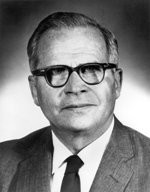Career
In addition to his work on the LP record, Goldmark developed field-sequential color technology for color television while at CBS. The system, first demonstrated on August 29, 1940, and shown to the press on September 3 used a rapidly rotating color wheel that alternated transmission in red, green and blue. The system transmitted on 343 lines, about 100 less than a black and white set, and at a different field scan rate, and thus was incompatible with television sets currently on the market without an adapter.
Although CBS did broadcast in color with the Goldmark system in 1950–1951, the "compatible color" technology developed for RCA and NBC (by a team led by Richard Kell, George H. Brown and others) was compatible with existing black and white TVs. Goldmark and others have pointed out that the CBS color wheel system did provide better picture quality (although lower image resolution) than RCA's system, but the compatibility problem proved its downfall. An improved RCA/NBC color system submitted in July 1953 became the industry standard chosen by the Federal Communications Commission (FCC) in December 1953. Ironically, cameras using the color wheel system continued to be used for scientific research for several more decades, including the color lunar surface TV cameras during all the 1970s NASA Apollo Moon landings.
After the success of the LP record, Goldmark spent the next two decades at CBS Laboratories working on various inventions, chief of which was EVR, the Electronic Video Recorder. This futuristic home video playback device used reels of film stored in plastic cassettes to electronically store audio and video signals, and was first announced in 1967. A B&W prototype was demonstrated in 1969 (promising color playback in future models), but the invention floundered when it proved to be difficult and costly to manufacture. CBS was also concerned about the potential of competition from home video devices, particularly those that could record — a fear that eventually proved prescient.
